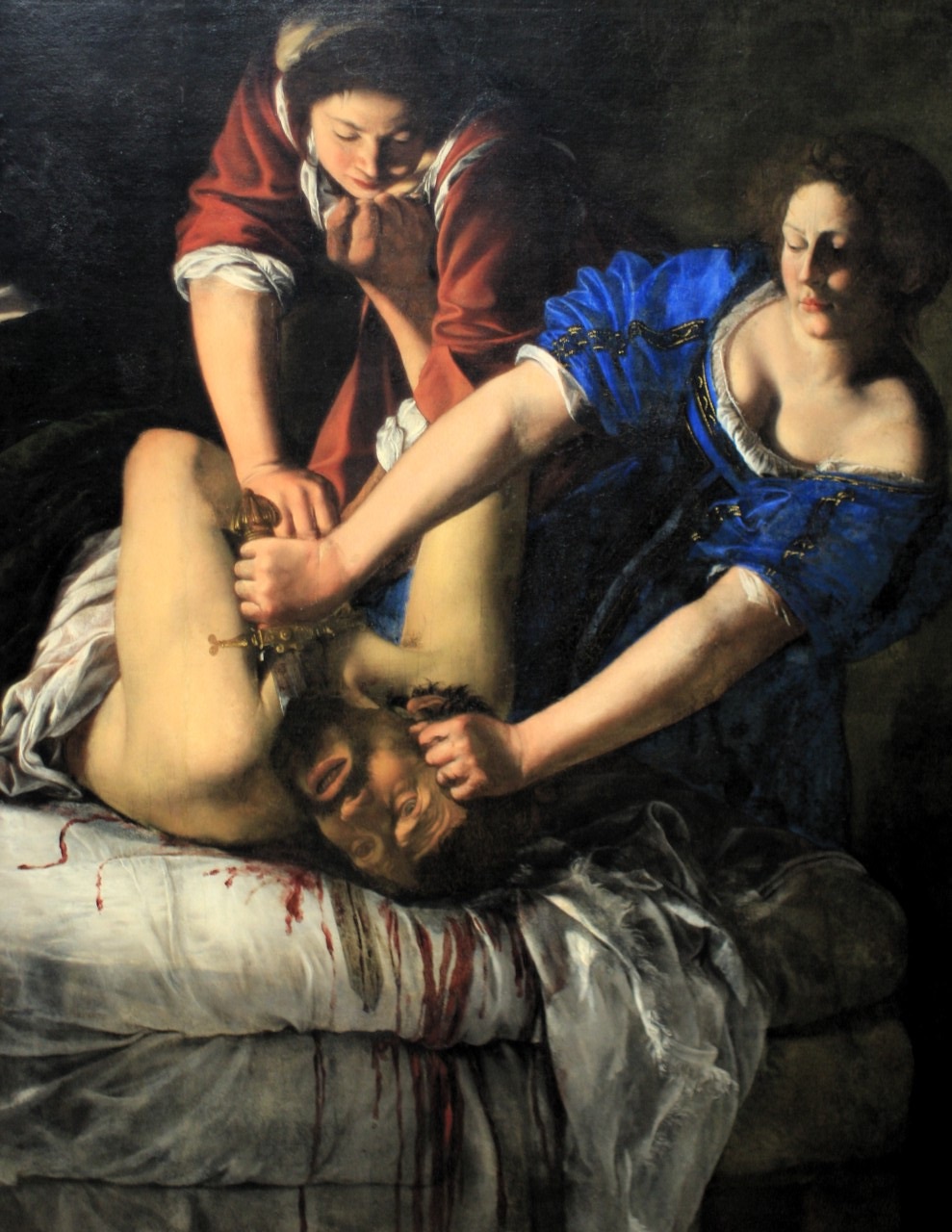Michael Palin’s Quest for Artemisia, BBC Four | reviews, news & interviews
Michael Palin’s Quest for Artemisia, BBC Four
Michael Palin’s Quest for Artemisia, BBC Four
The mysteries of an artistic life and reputation investigated by curious Python

For his latest journey Michael Palin, actor, writer, novelist, comedian, Python, traveller, has gone beyond geography in search of the visual arts with his characteristic enthusiasm, eclectic curiosity, and sense of discovery.
With his usual exuberance, here he persuasively described the packed life – and art – of that most unusual baroque painter Artemisia Gentileschi (1593-c.1655). He was inspired by sighting her ferociously violent take on Judith decapitating Holofernes (pictured below) in the Capodimonte Gallery in Naples where Artemisia lived – aside from several years in London – for the last decades of her adventurous life. Palin almost seemed personally slighted when he told us that this remarkable painting was not included in the official highlights of the Neapolitan museum.
Her strategies were commercial and business-like
Calling the programme a quest is accurate: Palin sees her as a modern woman in a patriarchal world, centuries ahead of her time, but the facts are elusive. Even the date of her death is not secure: sometime in the 1650s, in Naples, possibly of the plague. What is certain is that she was the only daughter of a somewhat successful follower of Caravaggio, the artist Orazio Gentileschi, and was brought up in the artistic quarter of Rome; her mother Prudencia died when Artemisia was 12. She took on a quasi-maternal role towards her younger brothers, who did not share her precocious artistic talent, while assisting her father in his work, learning all the while.
When she was perhaps 16, she was raped by Agostino Tassi, a painter of decorative schemes, who worked with her father. They evidently continued their liaison for some months in spite of the original rape. He took her virginity, and promised her marriage. But having destroyed her eligibility, he was found to have a living wife, whom he evidently planned to murder. The concerned father rather late in the day accused Agostino. The extensive documentation of the seven-month trial is held in Rome’s archives, complete with an account of the methods of using handscrews to assure the veracity of witnesses, including Artemisia, and a verbatim and savage account of the rape by Artemisia herself.
 Artemisia went on to become a successful artist in a man’s world. The underlying question was whether our view of Artemisia is more influenced by the melodrama, so far as it is known, of her life and loves, or by the quality of her art. Palin is a cheerleader for the art, but a number of female art historians believe her current popularity is fuelled by feminism. Our determined guide saw a consistency in her work, leading on from that early version of the beautiful Judith with tenacious determination beheading the Assyrian general Holofernes. She returned to the subject several times: a painting of statuesque young women and the dying soldier, his eyes wide open.
Artemisia went on to become a successful artist in a man’s world. The underlying question was whether our view of Artemisia is more influenced by the melodrama, so far as it is known, of her life and loves, or by the quality of her art. Palin is a cheerleader for the art, but a number of female art historians believe her current popularity is fuelled by feminism. Our determined guide saw a consistency in her work, leading on from that early version of the beautiful Judith with tenacious determination beheading the Assyrian general Holofernes. She returned to the subject several times: a painting of statuesque young women and the dying soldier, his eyes wide open.
Palin suggested her themes clustered around powerful women turning themselves from victims into survivors, and that she made them real rather than stereotypical. Her version of Susanna and the Elders, Palin claimed, is the first to show Susanna’s apprehension, rather than passively accepting her role as a helpless victim of the attention of lecherous old men. Other subjects include Bathsheba, Mary Magdalene, Cleopatra, Lucretia, and it was suggested that these were endowed with a new and immediate realism.
And yet for all the controversy surrounding her character and career there is no agreed version of her life and even her oeuvre, still in a state of flux: paintings are often reattributed and certainly rediscovered. The philanthropist Dr Jane Fortune has founded the organisation “Advancing Women Artists” and they have recently discovered a huge decorative scheme by Artemisia in the attics of the Pitti Palace, now being painstakingly restored by Nicola McGregor’s painting workshop in Florence.
She was secretly married, we were told, to the younger brother of her prosecuting lawyer in that protracted rape case; they moved to Florence, where she borrowed money in order to dress so expensively that she was noticed by potential patrons as she promenaded the fashionable streets. Her strategies were commercial and business-like; she was among the first women to be admitted to the Florentine Academy of art and design, and in the decadent dying days of the Medici dynasty they too commissioned her work. Yet it is thought half her work is lost or misattributed, and Mary Garrard told us her scholarly neglect is due to her gender; yet art historians do not want her claimed exclusively by feminists.
So the tale is tangled. Palin visited Rome, Florence and Naples in search of a consistent narrative, unclouded by the interpretations of the past three decades or so. Now that a securely attributed Artemisia can fetch – say – a million dollars, reattributions turn up from time to time. How much did her artist father contribute to her early paintings, how jealous was he of her talent, how much did her own workshop and studio contribute to her late paintings, when there was, we were shown, a considerable softening of the drama that infused her art at its peak?
The questions continue: does she receive attention now because of the quality of her art, or because of the uniqueness of her career? Did she take lovers after her marriage foundered? How many children did she have? There are documents attesting to several sons who died very young, and a daughter who lived to maturity, was herself an artist and then somehow also vanished from the records. Art historians continue to work on credible narratives of her life and art, and even in this passionately informed depiction both her personality and her painting somehow slipped in and out of focus.
rating
Explore topics
Share this article
The future of Arts Journalism
You can stop theartsdesk.com closing!
We urgently need financing to survive. Our fundraising drive has thus far raised £49,000 but we need to reach £100,000 or we will be forced to close. Please contribute here: https://gofund.me/c3f6033d
And if you can forward this information to anyone who might assist, we’d be grateful.

Subscribe to theartsdesk.com
Thank you for continuing to read our work on theartsdesk.com. For unlimited access to every article in its entirety, including our archive of more than 15,000 pieces, we're asking for £5 per month or £40 per year. We feel it's a very good deal, and hope you do too.
To take a subscription now simply click here.
And if you're looking for that extra gift for a friend or family member, why not treat them to a theartsdesk.com gift subscription?

Add comment